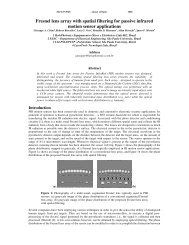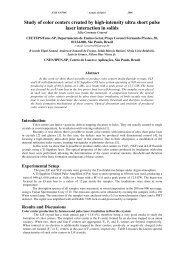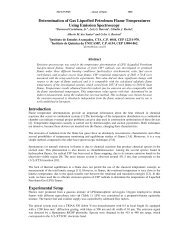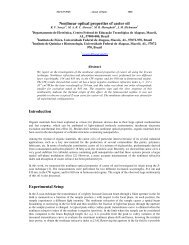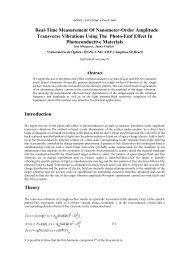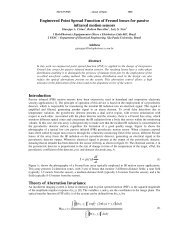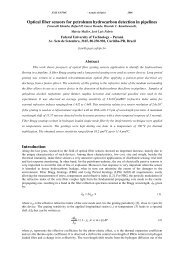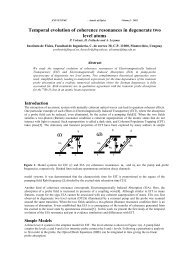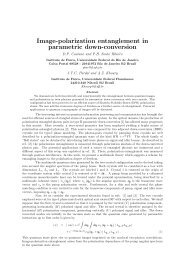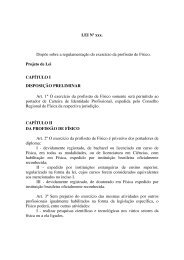CW Z-scan measurements in ionic liquids Introduction Experimental ...
CW Z-scan measurements in ionic liquids Introduction Experimental ...
CW Z-scan measurements in ionic liquids Introduction Experimental ...
You also want an ePaper? Increase the reach of your titles
YUMPU automatically turns print PDFs into web optimized ePapers that Google loves.
XXIX ENFMC - Annals of Optics 2006<br />
<strong>CW</strong> Z-<strong>scan</strong> <strong>measurements</strong> <strong>in</strong> <strong>ionic</strong> <strong>liquids</strong><br />
R. F. Souza 1* , M. A. R. C. Alencar 2 , M. R. Meneghetti 3 , J. Dupont 4 , J. M. Hickmann 2<br />
1 Departamento de Eletrônica, Centro Federal de Educação Tecnológica de Alagoas, Maceió,<br />
AL, 57000-000, Brazil<br />
2 Instituto de Física, Universidade Federal de Alagoas, Maceió, AL, 57072-970, Brazil<br />
3 Instituto de Química e Biotecnologia, Universidade Federal de Alagoas, Maceió, AL, 57072-<br />
970, Brazil<br />
4 Instituto de Química, Universidade Federal do Rio Grande do Sul, Porto Alegre, RS, 91501-<br />
970, Brazil<br />
* rogerio@loqnl.ufal.br<br />
Abstract<br />
We report on the first <strong>in</strong>vestigation of the nonl<strong>in</strong>ear optical properties of <strong>ionic</strong> <strong>liquids</strong>, us<strong>in</strong>g the<br />
Z-<strong>scan</strong> technique. These compounds are <strong>liquids</strong> at room temperature and present a strong <strong>ionic</strong><br />
nature. Nonl<strong>in</strong>ear refraction and absorption <strong>measurements</strong> of two k<strong>in</strong>ds of <strong>ionic</strong> <strong>liquids</strong> were<br />
performed for two different laser wavelengths, 514 and 810 nm, <strong>in</strong> the <strong>CW</strong> regime. The results<br />
showed that those specimens have large negative nonl<strong>in</strong>ear refractive <strong>in</strong>dexes, <strong>in</strong> the order of 10 -8<br />
to 10 -9 cm 2 /W for both laser wavelengths, however nonl<strong>in</strong>ear absorption was not observed.<br />
<strong>Introduction</strong><br />
A large number of photonic applications have been developed based on the nonl<strong>in</strong>ear optical properties of<br />
materials. Different k<strong>in</strong>ds of media have been studied and eng<strong>in</strong>eered aim<strong>in</strong>g their use <strong>in</strong> photonics devices.<br />
Among the myriad of studied compounds, organic materials (OM) are of great importance due to their large<br />
optical nonl<strong>in</strong>earities and fast responses [1]. However, a large number of OM has their optical properties<br />
currently un<strong>in</strong>vestigated, as <strong>ionic</strong> <strong>liquids</strong> for <strong>in</strong>stance.<br />
Ionic <strong>liquids</strong> are liquid compounds that display <strong>ionic</strong>-covalent crystall<strong>in</strong>e structures [2]. They have a relatively<br />
wide electrochemically stable w<strong>in</strong>dow, good electrical conductivity, high <strong>ionic</strong> mobility, negligible vapor<br />
pressure, and excellent chemical and thermal stability. These materials are important for a large number of<br />
applications <strong>in</strong> chemistry and <strong>in</strong>dustry, such as catalysis, batteries, chemical analysis and as a stabilizer for<br />
colloids conta<strong>in</strong><strong>in</strong>g nanoparticles.<br />
An important characteristic of these materials is that some of them possess liquid crystal properties [3,4], which<br />
<strong>in</strong>dicate that these compounds may present large nonl<strong>in</strong>ear optical responses. In this work, we <strong>in</strong>vestigated the<br />
nonl<strong>in</strong>ear optical properties of two different <strong>ionic</strong> liquid compounds us<strong>in</strong>g the Z-<strong>scan</strong> technique [5]. The<br />
<strong>measurements</strong> were performed for two different excitation wavelengths, 514 nm and 810 nm, <strong>in</strong> the <strong>CW</strong> regime.<br />
The orig<strong>in</strong> of the observed large nonl<strong>in</strong>earity of these <strong>ionic</strong> <strong>liquids</strong> is also discussed.<br />
<strong>Experimental</strong> Setup<br />
In the Z-<strong>scan</strong> technique the transmittance of a tightly focused Gaussian beam through a f<strong>in</strong>ite aperture <strong>in</strong> the far<br />
field is measured as a function of the sample position z with respect to the focal plane. At each position, the<br />
sample experiences a different light <strong>in</strong>tensity. The nonl<strong>in</strong>ear refraction of the sample causes a spatial beam<br />
broaden<strong>in</strong>g or narrow<strong>in</strong>g <strong>in</strong> the far field and thus modifies the fraction of light that passes through the aperture<br />
as the sample position is changed. A typical peak-valley (valley-peak) transmittance curve is obta<strong>in</strong>ed when the<br />
nonl<strong>in</strong>ear refractive <strong>in</strong>dex of the medium is negative (positive). In the limit where the sample can be considered<br />
th<strong>in</strong>, compared to the beam Rayleigh length (L < z 0 ), it is possible from the peak to valley variation of the<br />
measured transmittance curve to evaluate the maximum nonl<strong>in</strong>ear phase-shift and hence, know<strong>in</strong>g the <strong>in</strong>cident<br />
laser power, to obta<strong>in</strong> the nonl<strong>in</strong>ear refractive <strong>in</strong>dex n 2 [5,6]. Remov<strong>in</strong>g the aperture <strong>in</strong> the far field it is possible<br />
to perform nonl<strong>in</strong>ear absorption <strong>measurements</strong>. Such Z-<strong>scan</strong> traces are expected to be symmetric with respect to
XXIX ENFMC - Annals of Optics 2006<br />
the focal po<strong>in</strong>t (z = 0) where they exhibit a m<strong>in</strong>imum transmittance <strong>in</strong> the case of nonl<strong>in</strong>ear absorption<br />
(multiphoton absorption) and a maximum for the saturation absorption. For media exhibit<strong>in</strong>g both nonl<strong>in</strong>ear<br />
refraction and absorption properties, a closed aperture Z-<strong>scan</strong> measurement is sensitive to both effects. Divid<strong>in</strong>g<br />
the closed aperture data by the open aperture one yields a Z-<strong>scan</strong> trace typical of a purely refractive nonl<strong>in</strong>earity<br />
[5].<br />
The experimental setup used to measure the nonl<strong>in</strong>ear refractive <strong>in</strong>dex and absorption of our <strong>ionic</strong> liquid<br />
samples <strong>in</strong> this work is depicted <strong>in</strong> the Figure 1. A <strong>CW</strong> Argon laser (Ti:sapphire laser) operat<strong>in</strong>g at 514 nm (810<br />
nm) was used as a light source. The laser beam was modulated by a chopper and focused onto the sample by a<br />
convergent lens of 7.5 cm focal length. The sample consisted of a 1 mm quartz cuvette with<strong>in</strong> a small amount of<br />
our materials under <strong>in</strong>vestigation. It was mounted on a translation stage and moved around the lens focus (z = 0)<br />
by a computer controlled stepper motor. The light transmittance was then measured by a closed-aperture<br />
photodetector as a function of the sample position. The detected signal was amplified by a lock-<strong>in</strong> amplifier and<br />
then processed by a computer. Nonl<strong>in</strong>ear absorption <strong>measurements</strong> were performed us<strong>in</strong>g the same experimental<br />
setup but us<strong>in</strong>g an opened aperture configuration.<br />
Figure 1: <strong>Experimental</strong> setup for optical nonl<strong>in</strong>earity <strong>measurements</strong> us<strong>in</strong>g Z-<strong>scan</strong> technique.<br />
Results and Discussions<br />
Two k<strong>in</strong>ds of <strong>ionic</strong> <strong>liquids</strong> were <strong>in</strong>vestigated <strong>in</strong> this work: 1-n-butyl-3-methylimidazolium tetrafluoroborate<br />
(BMI-BF 4 ) and 1-n-butyl-3-methylimidazolium hexafluorophosphate (BMI-PF 6 ). The chemical structure of<br />
these compounds is presented <strong>in</strong> Figure 2, where X corresponds to BF 4 or PF 6 .<br />
Figure 2: Chemical structure of the <strong>ionic</strong> liquid.<br />
The l<strong>in</strong>ear UV-VIS absorption spectra of the <strong>ionic</strong> <strong>liquids</strong> BMI-BF 4 and BMI-PF 6 are presented <strong>in</strong> Figure 3. As<br />
can be seen <strong>in</strong> this figure, they are transparent <strong>in</strong> the UV-Visible and near <strong>in</strong>frared regions. The laser<br />
wavelengths used <strong>in</strong> our experiments are also <strong>in</strong>dicated <strong>in</strong> this figure.
XXIX ENFMC - Annals of Optics 2006<br />
Absorbance<br />
1.4<br />
1.2<br />
1.0<br />
0.8<br />
0.6<br />
0.4<br />
514 nm<br />
(a)<br />
810 nm<br />
Absorbance<br />
0.6<br />
0.5<br />
0.4<br />
0.3<br />
0.2<br />
514 nm<br />
(b)<br />
810 nm<br />
0.2<br />
0.1<br />
0.0<br />
300 400 500 600 700 800<br />
Wavelength (nm)<br />
0.0<br />
300 400 500 600 700 800<br />
Wavelength (nm)<br />
Figure 3: L<strong>in</strong>ear absorption spectra of <strong>ionic</strong> <strong>liquids</strong> (a) BMI-BF 4 and (b) BMI-PF 6 .<br />
Figure 4 shows the typical normalized transmittances, closed aperture, as a function of the sample position, for<br />
<strong>CW</strong> laser excitation tuned at 514 nm, for BMI-BF 4 and BMI-PF 6 <strong>ionic</strong> <strong>liquids</strong>. From the observed transmittance<br />
variations, the nonl<strong>in</strong>ear refractive <strong>in</strong>dex values n 2 were evaluated to be -3.7 x 10 -9 cm 2 /W and -2.0 x 10 -8<br />
cm 2 /W, respectively. Although this value is smaller than other materials, such as photorefractive crystals and<br />
ch<strong>in</strong>ese tea, this nonl<strong>in</strong>earity is much larger than several organic <strong>liquids</strong> as DMSO and CS 2 , for example.<br />
Normalized Transmittance<br />
1,3<br />
1,2<br />
1,1<br />
1,0<br />
0,9<br />
0,8<br />
(a)<br />
0,7<br />
-6 -4 -2 0 2 4 6<br />
z/z 0<br />
Normalized Transmittance<br />
1,3<br />
1,2<br />
1,1<br />
1,0<br />
0,9<br />
0,8<br />
0,7<br />
-6 -4 -2 0 2 4 6<br />
z/z 0<br />
(b)<br />
Figure 4: Z-<strong>scan</strong> curve for the <strong>ionic</strong> <strong>liquids</strong> (a) BMI-BF 4 , P laser = 25.4 mW and (b) BMI-PF 6 ,<br />
P laser = 15.2 mW at 514 nm.<br />
Typical Z-<strong>scan</strong> curves obta<strong>in</strong>ed for <strong>CW</strong> laser excitation tuned at 810 nm for both BMI-BF 4 and BMI-PF 6 are<br />
presented <strong>in</strong> Figure 5. The BMI-BF 4 <strong>ionic</strong> liquid presented a nonl<strong>in</strong>ear refractive <strong>in</strong>dex value n 2 = -3.0 x 10 -9<br />
cm 2 /W which is of the same order of magnitude that at 514 nm. However, for the BMI-PF 6 , the measured<br />
nonl<strong>in</strong>ear refractive <strong>in</strong>dex at 810 nm was n 2 = - 4.0 x 10 -9 cm 2 /W, which is much smaller than what was<br />
observed <strong>in</strong> the former case.<br />
Normalized Transmittance<br />
1,3<br />
1,2<br />
1,1<br />
1,0<br />
0,9<br />
0,8<br />
(a)<br />
0,7<br />
-6 -4 -2 0 2 4 6<br />
Normalized Transmittance<br />
1,3<br />
1,2<br />
1,1<br />
1,0<br />
0,9<br />
0,8<br />
(b)<br />
0,7<br />
-6 -4 -2 0 2 4 6<br />
z/z 0<br />
z/z 0<br />
Figure 5: Z-<strong>scan</strong> curve for the <strong>ionic</strong> <strong>liquids</strong> (a) BMI-BF 4 , P laser = 73.7 mW and (b) BMI-PF 6 ,<br />
P laser = 87.3 mW at 810 nm.
XXIX ENFMC - Annals of Optics 2006<br />
We also performed the Z-<strong>scan</strong> <strong>measurements</strong> with the opened aperture configuration. In this case, nonl<strong>in</strong>ear<br />
absorption was not observed at any experimental conditions exploited <strong>in</strong> this work.<br />
As the carried <strong>measurements</strong> were performed only <strong>in</strong> <strong>CW</strong> regime, the orig<strong>in</strong> of this large nonl<strong>in</strong>earity is not<br />
completely understood up to now. We believe that thermal effects give the ma<strong>in</strong> important contribution to the<br />
measured value of n 2 ; however, only after experiments <strong>in</strong> pulsed regime we would be able to quantify the<br />
electronic and thermal contributions more accurately. Another <strong>in</strong>terest<strong>in</strong>g po<strong>in</strong>t is that, for the sample BMI-PF 6 ,<br />
the value of n 2 is larger when the laser is tuned at 514 nm than at 810 nm, while the value is almost the same,<br />
with<strong>in</strong> the experimental error, for the sample BMI-BF 4 . This result suggests that although the compounds are<br />
similar, their nonl<strong>in</strong>ear dispersion relations are very different <strong>in</strong> this range of wavelengths.<br />
Conclusions<br />
We have carried out the first <strong>in</strong>vestigation, to the best of our knowledge, of the nonl<strong>in</strong>earity optical properties of<br />
two different <strong>ionic</strong> <strong>liquids</strong> us<strong>in</strong>g the Z-<strong>scan</strong> technique for two excitation wavelengths, 514nm and 810 nm, <strong>in</strong><br />
the <strong>CW</strong> regime. Large nonl<strong>in</strong>ear refractive <strong>in</strong>dexes were obta<strong>in</strong>ed for both wavelengths. This result suggests<br />
that this nonl<strong>in</strong>earity is ma<strong>in</strong>ly due to thermal effects, although experiments <strong>in</strong> pulsed laser regime are needed <strong>in</strong><br />
order to confirm this assumption. No nonl<strong>in</strong>ear absorption was observed for all experimental configurations.<br />
Acknowledgements<br />
The authors thank the Brazilian agencies Conselho Nacional de Desenvolvimento Científico e Tecnológico<br />
(CNPq), Fundação de Amparo à Pesquisa do Estado de Alagoas (FAPEAL), Coordenação de Aperfeiçoamento<br />
de Pessoal de Nível Superior (CAPES), Nanofoton network, Nanoanálise e Diagnóstico network, and<br />
F<strong>in</strong>anciadora de Estudos e Projetos (FINEP) for f<strong>in</strong>ancial support.<br />
References<br />
[1] P. N. Prasad and D. J. Williams, <strong>Introduction</strong> to Nonl<strong>in</strong>ear Optical Effects <strong>in</strong> Molecules and Polymers,<br />
Wiley-Interscience, New York (1991).<br />
[2] J. Dupont, R. F. de Souza and P. A. Z. Soares, Ionic Liquid (Molten Salt) Phase Organometalic Catalysis,<br />
Chem. Rev. 102, 3667 (2002).<br />
[3] C. J. Bowlas, D. W. Bruce and K. R. Seddon, Liquid-Crystall<strong>in</strong>e Ionic Liquids, Chem. Commun., 1625-<br />
1626 (1996).<br />
[4] C. M. Gordon, J. D. Holbrey, A. R. Kennedy and K. R. Seddon, Ionic Liquid Crystals:<br />
Hexafluorophosphate Salts, J. Mater. Chem. 8, 2627 (1998).<br />
[5] M. Sheik-Bahae, A. A. Said, T-H Wei, D. J. Hagan and E. W. Van Stryland, Sensitive Measurement of<br />
Optical Nonl<strong>in</strong>earities Us<strong>in</strong>g a S<strong>in</strong>gle Beam, IEEE J. Quantum Electron. 26, 760 (1990).<br />
[6] I. P. Nikolakakos, A. Major, J. S. Aitchison and P. W. E. Smith, Broadband Characterization of the<br />
Nonl<strong>in</strong>ear Optical Properties of Common Reference Materials, IEEE J. of Sel. Top. In Quantum Electron.<br />
10, 1164 (2004).



